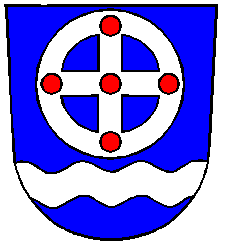Pirita: Difference between revisions
Jump to navigation
Jump to search
Knorrepoes (talk | contribs) m (Text replace - "http://www.rk.ee/symb/" to "http://valitsus.ee/et/riigikantselei/riigi-ja-omavalitsuste-symbolid/") |
Knorrepoes (talk | contribs) m (Text replace - "[[Literature" to "{{media}} [[Literature") |
||
| Line 19: | Line 19: | ||
The arms are based on the symbol of the Brigittine nuns, as the area developed around a monastery from that order founded in 1407. The five red balls refer to the 5 wounds of Christ. The wavy base symbolises the local Piritajõgi river. | The arms are based on the symbol of the Brigittine nuns, as the area developed around a monastery from that order founded in 1407. The five red balls refer to the 5 wounds of Christ. The wavy base symbolises the local Piritajõgi river. | ||
{{media}} | |||
[[Literature]] : Image taken from http://valitsus.ee/et/riigikantselei/riigi-ja-omavalitsuste-symbolid/ and Troels P. Roland | [[Literature]] : Image taken from http://valitsus.ee/et/riigikantselei/riigi-ja-omavalitsuste-symbolid/ and Troels P. Roland | ||
Revision as of 03:33, 9 July 2014
| Heraldry of the World Civic heraldry of Estonia |
PIRITA
County: Harjumaa
Part of : Tallinn
Official blazon
Sinisel kilbil hõbedane rõngasrist, milles viis purpurset sõõri 1+3+1. Rõngasristi all hõbedane laineline palk.
Origin/meaning
The arms were officially granted on December 20, 1994.
The arms are based on the symbol of the Brigittine nuns, as the area developed around a monastery from that order founded in 1407. The five red balls refer to the 5 wounds of Christ. The wavy base symbolises the local Piritajõgi river.
Contact and Support
Partners:
Your logo here ?
Contact us
© since 1995, Heraldry of the World, Ralf Hartemink 
Index of the site
Literature : Image taken from http://valitsus.ee/et/riigikantselei/riigi-ja-omavalitsuste-symbolid/ and Troels P. Roland










